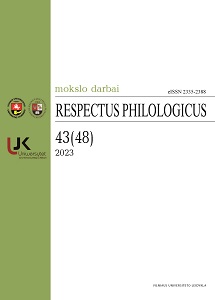Konotacja w średniowiecznych grupach apozycyjnych
The Connotation in Medieval Appositional Groups
Author(s): Piotr ZbrógSubject(s): Language studies, Theoretical Linguistics, Syntax
Published by: Vilniaus Universiteto Leidykla
Keywords: connotation; apposition group;
Summary/Abstract: Connotation as a syntactic mechanism of announcing a specific component in a sentence occurs or not in appositional groups. Based on the test for the non-ellipticity (or ellipticity) of the utterance, it can be determined whether the opposition base or the apposition itself is connoted (the sentence is then incomplete) or not (after the ellipse of the component, the sentence is still complete). Old Polish appositional groups of the type James and John, sons of Zebedee; Bolesław, priest and heir; chapter „Ut noxius” were reviewed in this article. They have been recorded from all monuments of the Polish language and constitute a representative collection of constructions of this type at that time. As a result of the analysis, it was found that in some types of expressions, the base was connoted (Mary, rose lights) or apposition (You, Lord). There were also groups with an unconnoted base (Piotr mayor from Koźmin) and an unconnoted apposition (stone, margarita). On this basis, the typology of the analyzed groups was established, distinguishing groups with unconnoted base and apposition, with connoted base and apposition, with unconnoted base and connoted apposition, and with connoted base and unconnoted apposition.
Journal: Respectus Philologicus
- Issue Year: 2023
- Issue No: 43 (48)
- Page Range: 49-61
- Page Count: 13
- Language: Polish

